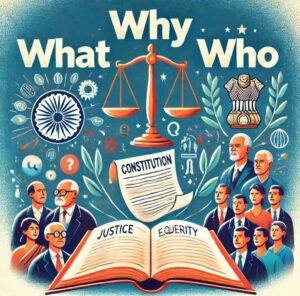Constitutional Design : Class 9 Civics
Welcome to Triple W: What, Why, and Who of Constitutional Design
In this blog post, we dive into the essentials of constitutional design for Class 9 Civics, Chapter 3, through the lens of the “Triple W” approach: What, Why, and Who. Here, we explore What a constitution is, Why it’s essential for a country, and Who were the key figures in creating the constitutional framework of independent India. This chapter provides invaluable insights into the purpose and importance of a constitution, guiding us through South Africa’s inspiring journey to freedom and India’s path to democracy. By the end, you’ll have a clear grasp of the chapter’s highlights, including the visionary work of Dr. B.R. Ambedkar and the Constituent Assembly, as well as the core principles that form the foundation of the Indian Constitution.
So let’s get started and break down the constitutional basics with “Triple W”—your go-to guide to understanding how the blueprint of democracy was laid out!
Q1. Why does a country need a constitution?
Ans: A country needs a constitution because:
- It provides a set of rules and principles for governing a country.
- It defines the rights of citizens and limits the power of the government.
- It safeguards against the misuse of power by those in authority.
- It reflects the ideals and aspirations of the people, especially in a democracy.
- It helps to maintain order, stability, and justice in society.
Q2. Describe the struggle for freedom in South Africa.
Ans: South Africa’s struggle for freedom was primarily against the system of apartheid, a form of racial discrimination that segregated people based on their race. The white minority held all the power, while the black majority had almost no rights. Nelson Mandela and the African National Congress (ANC) led the movement against apartheid. After years of protest, negotiations, and international pressure, apartheid was abolished, and in 1994, South Africa held its first multiracial elections, resulting in Mandela becoming the first black president of South Africa.
Q3. What are the key features of the South African Constitution?
Ans: The key features of the South African Constitution include:
- Equality: All people are equal and have equal rights.
- Non-discrimination: Discrimination on the basis of race, gender, or religion is prohibited.
- Protection of Fundamental Rights: Every citizen has fundamental rights, including freedom, dignity, and privacy.
- Provision for Reconciliation: Acknowledging past injustices and focusing on building a fair and just society for all races.
Q4. What do you understand by the term “Constituent Assembly”? Why was it formed in India?
Ans: A Constituent Assembly is a body of representatives chosen to draft or adopt a constitution for a country. In India, the Constituent Assembly was formed in 1946 to frame a new constitution after independence from British rule. The Assembly’s task was to design a constitution that would reflect the aspirations of the Indian people and provide a framework for a democratic government.
Q5. Describe the role of Dr. B.R. Ambedkar in drafting the Indian Constitution.
Ans: Dr. B.R. Ambedkar played a crucial role as the Chairman of the Drafting Committee of the Indian Constitution. He is often called the “Father of the Indian Constitution” because he meticulously guided the drafting process and ensured that the Constitution upheld values of justice, liberty, equality, and fraternity. He worked to protect the rights of marginalized communities and to make the Constitution inclusive for all Indians.
Q6. What are the main principles of the Indian Constitution?
Ans: The main principles of the Indian Constitution are:
- Sovereignty: India is an independent nation and is free to make its own decisions.
- Democracy: The government is elected by the people and is accountable to them.
- Secularism: There is no official religion, and all religions are treated equally.
- Socialism: The Constitution aims to reduce inequality and promote social welfare.
- Justice, Liberty, Equality, and Fraternity: These principles ensure fairness, freedom, and unity among citizens.
Q7. Why is the Indian Constitution considered unique?
Ans: The Indian Constitution is considered unique because:
- It is one of the longest written constitutions in the world.
- It provides a detailed structure for a democratic government and a secular state.
- It includes a comprehensive list of Fundamental Rights for citizens.
- It incorporates principles from several other constitutions but adapts them to India’s specific context.
- It is flexible, allowing amendments to meet changing needs.
These questions and answers cover the essential aspects of Chapter 3, “Constitutional Design.” They give a clear understanding of why a constitution is necessary, the historical background of India’s constitution-making process, and its key features.
Disclaimer :
This blog post is intended for educational purposes only, providing information based on the NCERT Class 9 Civics curriculum, specifically Chapter 3: Constitutional Design. While we strive for accuracy, please refer to official NCERT textbooks and educational resources for authoritative content. This post does not replace professional or legal advice regarding constitutional topics.
Do you want YouTube Thumbnail Downloader then whatsapp me (on 8887934356) “YTBD”
